Long photograph of the Moon
NASA created this lovely high resolution view of the Moon doing one complete rotation using footage from the Lunar Reconnaissance Orbiter.
(via @Colossal)



This site is made possible by member support. 💞
Big thanks to Arcustech for hosting the site and offering amazing tech support.
When you buy through links on kottke.org, I may earn an affiliate commission. Thanks for supporting the site!
kottke.org. home of fine hypertext products since 1998.
NASA created this lovely high resolution view of the Moon doing one complete rotation using footage from the Lunar Reconnaissance Orbiter.
(via @Colossal)
Paul Bogard recently published a book on darkness called The End of Night. Nicola Twilley and Geoff Manaugh interviewed Bogard about the book, the night sky, astronomy, security, cities, and prisons, among other things. The interview is interesting throughout but one of my favorite things is this illustration of the Bortle scale.
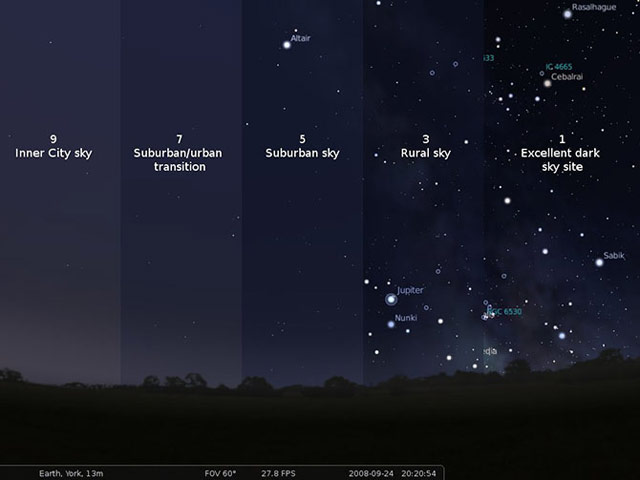
Twilley: It’s astonishing to read the description of a Bortle Class 1, where the Milky Way is actually capable of casting shadows!
Bogard: It is. There’s a statistic that I quote, which is that eight of every ten kids born in the United States today will never experience a sky dark enough to see the Milky Way. The Milky Way becomes visible at 3 or 4 on the Bortle scale. That’s not even down to a 1. One is pretty stringent. I’ve been in some really dark places that might not have qualified as a 1, just because there was a glow of a city way off in the distance, on the horizon. You can’t have any signs of artificial light to qualify as a Bortle Class 1.
A Bortle Class 1 is so dark that it’s bright. That’s the great thing-the darker it gets, if it’s clear, the brighter the night is. That’s something we never see either, because it’s so artificially bright in all the places we live. We never see the natural light of the night sky.
I can also recommend reading David Owen’s 2007 NYer piece on light pollution.
How many people are in space right now? is a single serving site that will give you the answer, along with the astronauts’ names, ranks, nationalities, and how long they’ve been in space.
As of August 26, 2013, these six people have emigrated from Earth’s atmosphere and not yet returned:
When I was a kid, I always thought that by the time I was an adult, we would have town-sized colonies in space stations around Earth, even if nowhere else. But getting and keeping human beings in space is hard, and robots have gotten very smart. Still, when I think about the rise of commercial human spaceflight, part of me is like “I don’t just want to shoot into space like a soda can and do one lousy orbit!” — as if that wouldn’t be the most magical experience of my life. It doesn’t matter. What I really want is to do a semester abroad.
Hats tipped to Zach Seward, Melody Kramer, and Sharon Jacobs.
If you’re at all interested in the Pioneer Anomaly (and you really should be, it’s fascinating), The Pioneer Detectives ebook by Konstantin Kakaes looks interesting.
Explore one of the greatest scientific mysteries of our time, the Pioneer Anomaly: in the 1980s, NASA scientists detected an unknown force acting on the spacecraft Pioneer 10, the first man-made object to journey through the asteroid belt and study Jupiter, eventually leaving the solar system. No one seemed able to agree on a cause. (Dark matter? Tensor-vector-scalar gravity? Collisions with gravitons?) What did seem clear to those who became obsessed with it was that the Pioneer Anomaly had the potential to upend Einstein and Newton — to change everything we know about the universe.
Kakaes was a science writer for The Economist and studied physics at Harvard, so this topic seems right up his alley. Available for $2.99 for the Kindle and for iBooks on iOS.
Randall Munroe of XKCD drew the Saturn V rocket (aka Up Goer Five) annotated using only the 1000 most common English words.
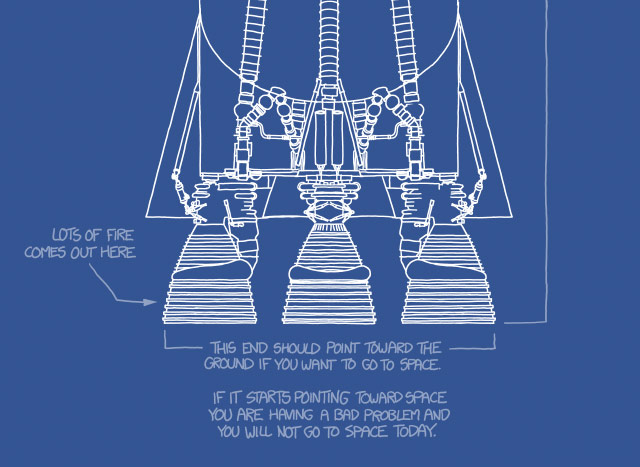
See also Albert Einstein’s Theory of Relativity In Words of Four Letters or Less.
Fabio Di Donato made this fantastic short film about Saturn using hundreds of thousands of images taken by the Cassini-Huygens spacecraft.
I love the editing technique employed here…the film feels like a silent short from the 1920s but also very contemporary. (via ★interesting)
Romanian photographer Maximilian Teodorescu recently caught the International Space Station in transit across the Sun.
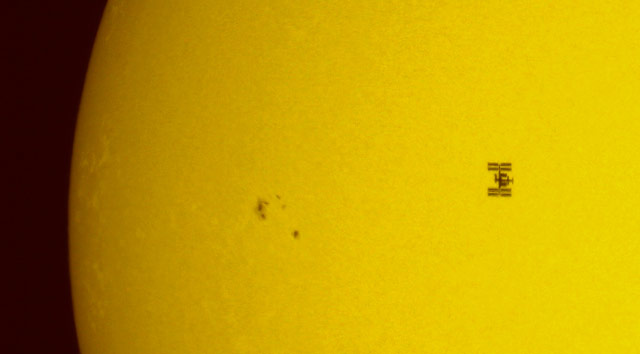
Teodorescu has also taken photos of the ISS in transit across the Moon.
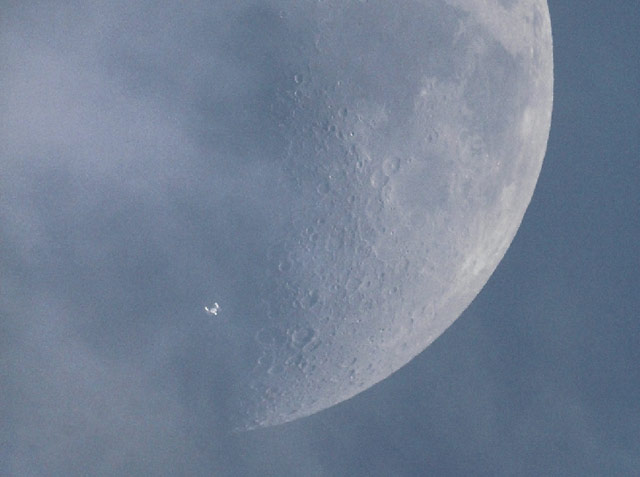
These photos make the ISS seem tiny and huge all at the same time. And be sure to click through on the links to see the full-sized photos.
The latest trailer for Gravity, starring Bullock and Clooney and directed by Alfonso Cuarón (who directed Children of Men).
Holy God, this looks terrifying. Can’t wait. (via ★interesting)
Turning the Sun into a giant radio telescope through gravitational lensing will take some work, but it is possible.
An Italian space scientist, Claudio Maccone, believes that gravitational lensing could be used for something even more extraordinary: searching for radio signals from alien civilizations. Maccone wants to use the sun as a gravitational lens to make an extraordinarily sensitive radio telescope. He did not invent the idea, which he calls FOCAL, but he has studied it more deeply than anyone else. A radio telescope at a gravitational focal point of the sun would be incredibly sensitive. (Unlike an optical lens, a gravitational lens actually has many focal points that lie along a straight line, called a focal line; imagine a line running through an observer, the center of the lens, and the target.) For one particular frequency that has been proposed as a channel for interstellar communication, a telescope would amplify the signal by a factor of 1.3 quadrillion.
This is incredible: an outfit called Pocket Spacecraft are making paper-thin “spacecraft” the size of CDs, hundreds of which will be placed into a rocket and sent to the Moon. They’re funding the project on Kickstarter and you can purchase your very own Moon-bound spacecraft for as little as £199.
Planetary Resources, an asteroid mining company (no, really!), has launched a $1 million Kickstarter campaign for “a space telescope for everyone”.
The ARKYD is a technologically advanced, orbiting space telescope that will be controlled by YOU, the crowd, through your pledges and community involvement! You can even direct your telescope time to non-profit science centers and universities for use in your communities!
How long before Reddit raises a bunch of funds to point the telescope at some venting gases on Uranus all day every day?
When Commander Chris Hadfield covered David Bowie’s Space Oddity on board the International Space Station:
how were the intellectual property rights handled?
The song “Space Oddity” is under copyright protection in most countries, and the rights to it belong to Mr Bowie. But compulsory-licensing rights in many nations mean that any composition that has been released to the public (free or commercially) as an audio recording may be recorded again and sold by others for a statutorily defined fee, although it must be substantively the same music and lyrics as the original. But with the ISS circling the globe, which jurisdiction was Commander Hadfield in when he recorded the song and video? Moreover, compulsory-licensing rights for covers of existing songs do not include permission for broadcast or video distribution. Commander Hadfield’s song was loaded onto YouTube, which delivers video on demand to users in many countries around the world. The first time the video was streamed in each country constituted publication in that country, and with it the potential for copyright infringement under local laws. Commander Hadfield could have made matters even more complicated by broadcasting live as he sang to an assembled audience of fellow astronauts for an onboard public performance while floating from segment to segment of the ISS.
We live in a world where sending a guitar into space is trivial while ironing out rights agreements is the tough part. (via waxy)
Momofuku’s David Chang cooks up some gourmet space food for celeb astronaut Chris Hadfield.
Unfortunately, it doesn’t work out so well. Who knew that gravity was so useful? But stay for the best part of the whole thing…right at the end, Hadfield feeds himself asparagus like a fish.
From XKCD, a chart of the memes that various star systems are just hearing from the Earth’s light-speed communications.
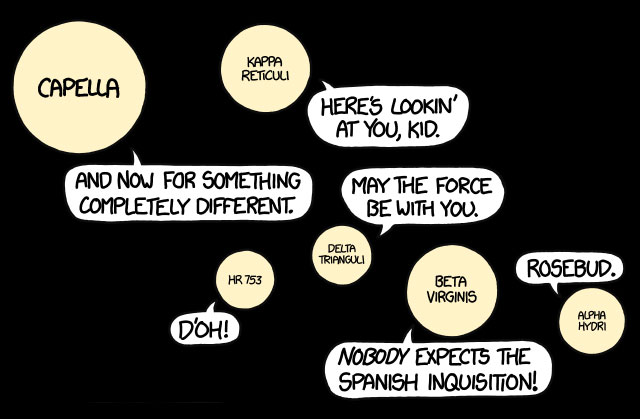
This is the meme version of Contact’s opening credits scene, which is one of my favorites:
How appropriate that at the height of the Cold War, in which the United States was attempting to spend the Soviet Union into collapse (a task at which they eventually succeeded), the Soviets cloned the buggiest, most inconsistant part of the US space program.
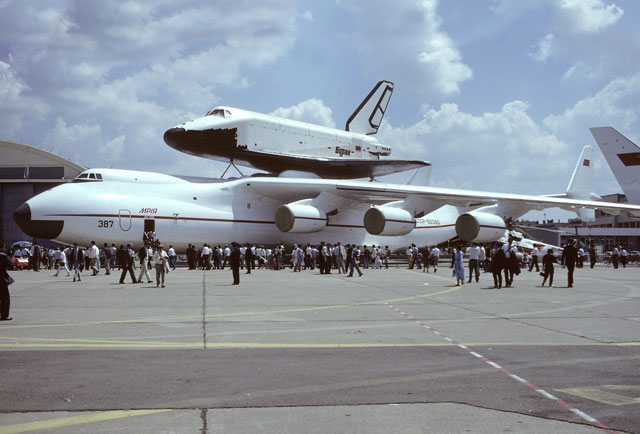
Called Buran (Russian for blizzard or snowstorm), the program was launched by the Kremlin as a reaction to NASA’s space shuttle and an attempt to gain an edge in space against the backdrop of Ronald Reagan’s “Star Wars” Strategic Defense Initiative. It was also an attempt to fulfill the Soviet Union’s dream of reusable spacecraft and payloads, ideas that predated the American space program.
A massive effort began. Over a million and a half people worked on the multi-billion dollar project, while researchers developed new, elaborate schemes for Russian space exploration. Among other tasks, Russian scientists hoped that the Buran would be able to carry the space station back to Earth, and — the reported reason for its inception — to allow the USSR to carry out military attacks from space.
And from Maciej Ceglowski’s epic takedown of the Shuttle program, this little tidbit:
The Soviet Shuttle, the Buran (snowstorm) was an aerodynamic clone of the American orbiter, but incorporated many original features that had been considered and rejected for the American program, such as all-liquid rocket boosters, jet engines, ejection seats and an unmanned flight capability. You know you’re in trouble when the Russians are adding safety features to your design.
(via @Mike_FTW)
The quick progress of the US space program in the 1960s and 70s and the science fiction of the 70s and 80s seemed to point towards humans living permanently in space. What happened?
Ironically, our actual experiments in space living have largely reinforced this stark perspective. Real life in space is often cramped, unpleasant and even pointless. Some years back, I visited Star City near Moscow, the training centre for cosmonauts since Gagarin, where I had a chance to clamber inside a full-scale training mock-up of the Mir space station. The experience was more like residing inside a computer terminal than one of O’Neill’s cylindrical islands, so proximate and abundant were tubes, wires, levers, buttons and unnameable gadgets.
More disorienting was the placement of controls and conveniences: because space was limited, these were distributed throughout the station without reference to Earthly gravity, thus making use of ‘ceilings’ as sleeping quarters, walls for toilet cubicles and virtually any other surface for any other activity. One could get used to such things (and you’d have to be a true cynic to tire of the view outside your window). But it’s a far, far cry from strolling the wide corridors of the Starship Enterprise.
They promised us life in space, flying cars, and jetpacks but all we got were pocket-sized rectangles containing all human knowledge. FAIL.
Since 861 AD, almost 35,000 meteorites were recorded hitting the Earth but only 1,045 were actually seen falling. This animated infographic is a good way to visualize the data. Bolides is the perfect domain name. (via @DavidGrann)
What happens when you wring a washcloth out in zero gravity? Something cool.
Commander Hadfield is the best. I love when he casually lets go of the wireless mic and it just floats there right in front of his face. (thx, dusty)
Great article by Burkhard Bilger about NASA’s Curiosity mission to Mars.
The search for life on Mars is now in its sixth decade. Forty spacecraft have been sent there, and not one has found a single fossil or living thing. The closer we look, the more hostile the planet seems: parched and frozen in every season, its atmosphere inert and murderously thin, its surface scoured by solar winds. By the time Earth took its first breath three billion years ago, geologists now believe, Mars had been suffocating for a billion years. The air had thinned and rivers evaporated; dust storms swept up and ice caps seized what was left of the water. The Great Desiccation Event, as it’s sometimes called, is even more of a mystery than the Great Oxygenation on Earth. We know only this: one planet lived and the other died. One turned green, the other red.
Perfect read if you’ve been curious about what Curiosity is up to on Mars but needed something a bit more narrative than the mission home page or Wikipedia page to guide you. Also features the phrase “a self-eating watermelon of despair”, so there’s that. Oh, and here’s the Seven Minutes of Terror video referred to in the story.
In the pages of Sidereus Nuncius, Galileo described the four large moons of Jupiter in a series of 64 sketches which looked a lot like ASCII art in the text:
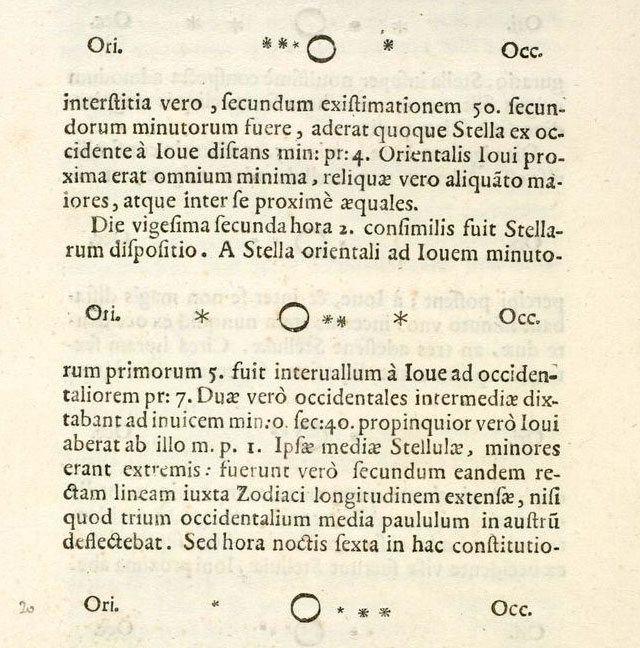
Using an online tool for computing the positions of Jupiter’s moons, Ernie Wright compared Galileo’s sketches to the moons’ actual motions.

Click through for an animated GIF of all the comparisons. Not bad for the telescopic state of the art in 1610. For a taste of how celestial objects actually appeared when viewed through Galileo’s telescope, check out this video starting around 7:30. (thx, john)
It’s science fiction for now, but two companies are betting that mining asteroids for minerals will be possible in the near future.
The potential bonanza is, well, astronomical. A single 500-metre metal-rich asteroid might contain the equivalent of all the platinum-group metals mined to date. Icy bodies could provide water to sustain astronauts or be processed into rocket fuel for future missions to Mars.
Since the Sun moves relative to the other stars around it at about 45,000 miles/hr, if you change the frame of reference from the Sun to the surrounding stellar system, you get planetary motion that looks something like this:
I would take this video with a grain of salt though, especially when it says things like “the Sun is like a comet, dragging the planets in its wake”…the planets don’t lag behind the Sun. Better to think of the thing as a conceptual schematic: resembling reality but not really accurate. (via @pieratt)
Update: There’s a new version of the video that addresses some of the concerns raised about the first video:
(thx, john)
Update: Phil Plait from Bad Astronomy has posted a pretty thorough takedown of this video.
However, there’s a problem with it: It’s wrong. And not just superficially; it’s deeply wrong, based on a very wrong premise. While there are some useful visualizations in it, I caution people to take it with a galaxy-sized grain of salt.
So far, humans have taken photos from the surfaces of Earth, the Moon, Venus, and Mars. But I had no idea that a photo from the surface of Titan existed:
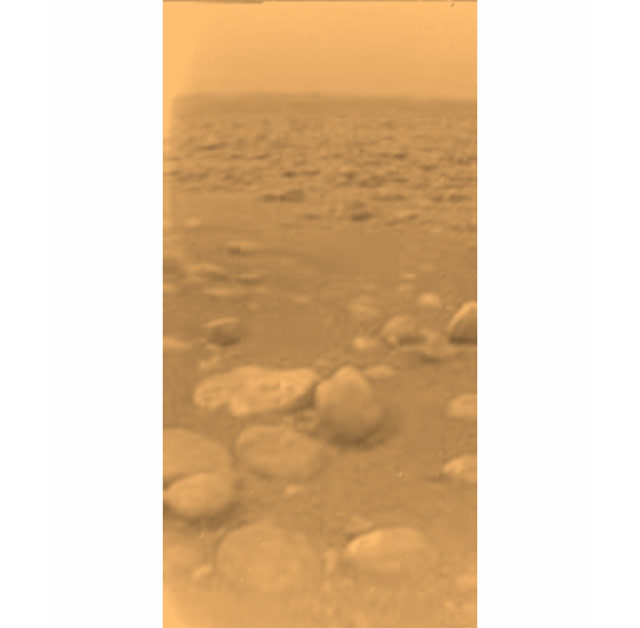
The photo of the Saturnian moon was taken in 2005 by the Huygens probe, which was designed to land safely on the moon’s surface. From Wikipedia:
After landing, Huygens photographed a dark plain covered in small rocks and pebbles, which are composed of water ice. The two rocks just below the middle of the image on the right are smaller than they may appear: the left-hand one is 15 centimeters across, and the one in the center is 4 centimeters across, at a distance of about 85 centimeters from Huygens. There is evidence of erosion at the base of the rocks, indicating possible fluvial activity. The surface is darker than originally expected, consisting of a mixture of water and hydrocarbon ice. The assumption is that the “soil” visible in the images is precipitation from the hydrocarbon haze above.
And a special close-but-no-cigar award goes to the NEAR Shoemaker probe, which snapped this photo from about 400 feet above the surface of the near-Earth asteroid Eros:
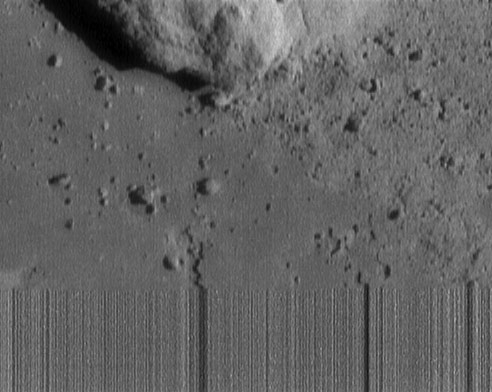
The probe landed on the surface of Eros in February 2001 and transmitted usable data for about two weeks afterwards, none of which was photographic in nature.
It would look something like this:
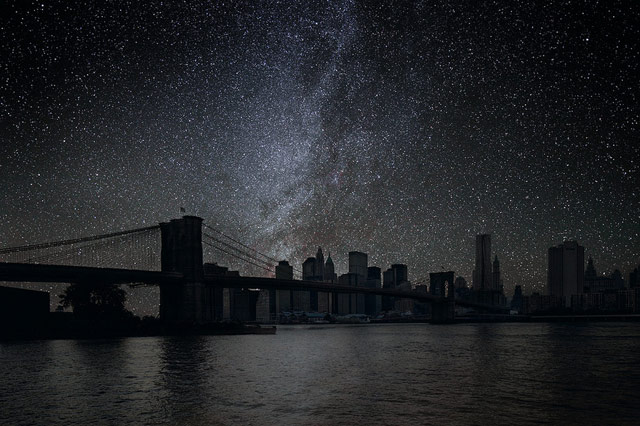
That’s from a series called Darkened Skies by Thierry Cohen; he photographed various cities (NYC, Paris, Tokyo, SF) and matched them up with starry skies from more remote places like Montana, Nevada, and the Sahara. New Yorkers can see Cohen’s work at the Danziger Gallery starting March 28.
See also Imagining Earth with Saturn’s Rings.
Another fine installment of XKCD’s What If? series: What would happen if you tried to fly a normal Earth airplane above different Solar System bodies?
Unfortunately, [the X-Plane simulator] is not capable of simulating the hellish environment near the surface of Venus. But physics calculations give us an idea of what flight there would be like. The upshot is: Your plane would fly pretty well, except it would be on fire the whole time, and then it would stop flying, and then stop being a plane.
(via stellar)
The Space Shuttle Challenger disintegrated shortly after liftoff 27 years ago today. Physicist Richard Feynman had a hand in determining the reason for the disaster.
I’m an explorer, ok? I get curious about everything and I want to investigate all kinds of stuff.
Here’s Feynman’s appendix to The Presidential Commission on the Space Shuttle Challenger Accident in which he dissents with the majority opinion of the commission. His conclusion:
If a reasonable launch schedule is to be maintained, engineering often cannot be done fast enough to keep up with the expectations of originally conservative certification criteria designed to guarantee a very safe vehicle. In these situations, subtly, and often with apparently logical arguments, the criteria are altered so that flights may still be certified in time. They therefore fly in a relatively unsafe condition, with a chance of failure of the order of a percent (it is difficult to be more accurate).
Official management, on the other hand, claims to believe the probability of failure is a thousand times less. One reason for this may be an attempt to assure the government of NASA perfection and success in order to ensure the supply of funds. The other may be that they sincerely believed it to be true, demonstrating an almost incredible lack of communication between themselves and their working engineers.
In any event this has had very unfortunate consequences, the most serious of which is to encourage ordinary citizens to fly in such a dangerous machine, as if it had attained the safety of an ordinary airliner. The astronauts, like test pilots, should know their risks, and we honor them for their courage. Who can doubt that McAuliffe was equally a person of great courage, who was closer to an awareness of the true risk than NASA management would have us believe?
Let us make recommendations to ensure that NASA officials deal in a world of reality in understanding technological weaknesses and imperfections well enough to be actively trying to eliminate them. They must live in reality in comparing the costs and utility of the Shuttle to other methods of entering space. And they must be realistic in making contracts, in estimating costs, and the difficulty of the projects. Only realistic flight schedules should be proposed, schedules that have a reasonable chance of being met. If in this way the government would not support them, then so be it. NASA owes it to the citizens from whom it asks support to be frank, honest, and informative, so that these citizens can make the wisest decisions for the use of their limited resources.
For a successful technology, reality must take precedence over public relations, for nature cannot be fooled.
Clear thought, clear writing. Feynman was perhaps the most efficient mechanism ever conceived for consuming complexity and pumping out simplicity. (via @ptak)
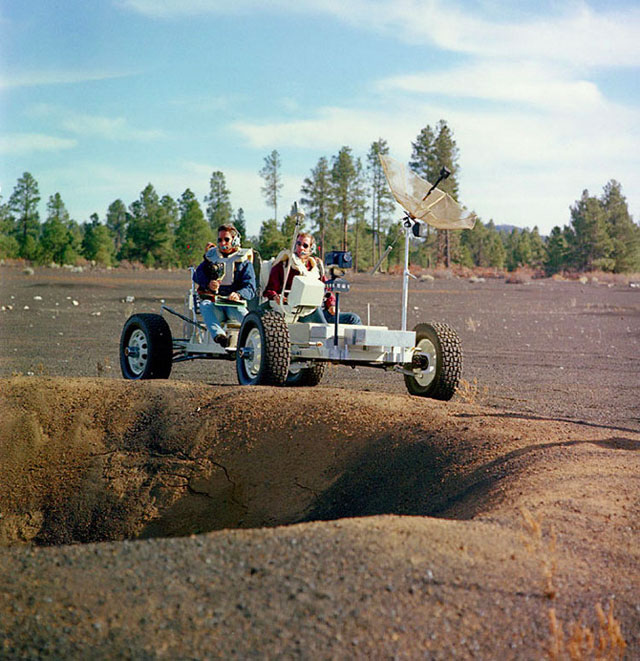
At a training site in Arizona called Cinder Lake, NASA created a “simulated lunar environment” for the purpose of testing lunar rovers and other pieces of equipment.
At the end of a four-day period of controlled explosions, USGS scientists had succeeded in creating a 500 square foot “simulated lunar environment” in Northern Arizona — forty-seven craters of between five and forty feet in diameter designed to duplicate at a 1:1 scale a specific location (and future Apollo 11 landing site) on the moon, in a region called the Mare Tranquillitatis.
If they faked the Moon landing, this is probably where they did it.
I had no idea there was footage shot on the Moon from the perspective of a lunar rover passenger…basically a lunar rover dash cam. It’s the second half of this short video. Amazing. The first part shows the rover speeding off (at about 6 miles/hr), being put through its paces. From the transcript of the “Grand Prix”:
124:58:52 Duke: The suspension system on that thing is fantastic!
124:58:54 England: That sounds good. We sound like we probably got enough of the Grand Prix. We’re willing to let you go on from here. Call that a (complete) Grand Prix.
124:59:03 Duke: Okay. (Pause) Man, that was all four wheels off the ground, there. Okay. Max stop.
124:59:12 Young: Okay. I don’t want to do that.
124:59:13 Duke: Okay. Excuse me.
124:59:16 Young: They say that’s a no-no.
124:59:22 Duke: Okay, DAC off; Mark. Okay, John. DAC’s off.
124:59:27 Young: Okay. I have a lot of confidence in the stability of this contraption.
124:59:30 Duke: Me, too.
124:59:32 England: Sounds great.
Also, we took a fucking car to the Moon! Three times!
Filmmaker S.G. Collins argues that in 1969, it was easier to send people to the Moon than to fake the landing in a studio. Technologically speaking, it was impossible to shoot that video anywhere other than the surface of the Moon. Which sounds crazy.
(via devour)
Stay Connected